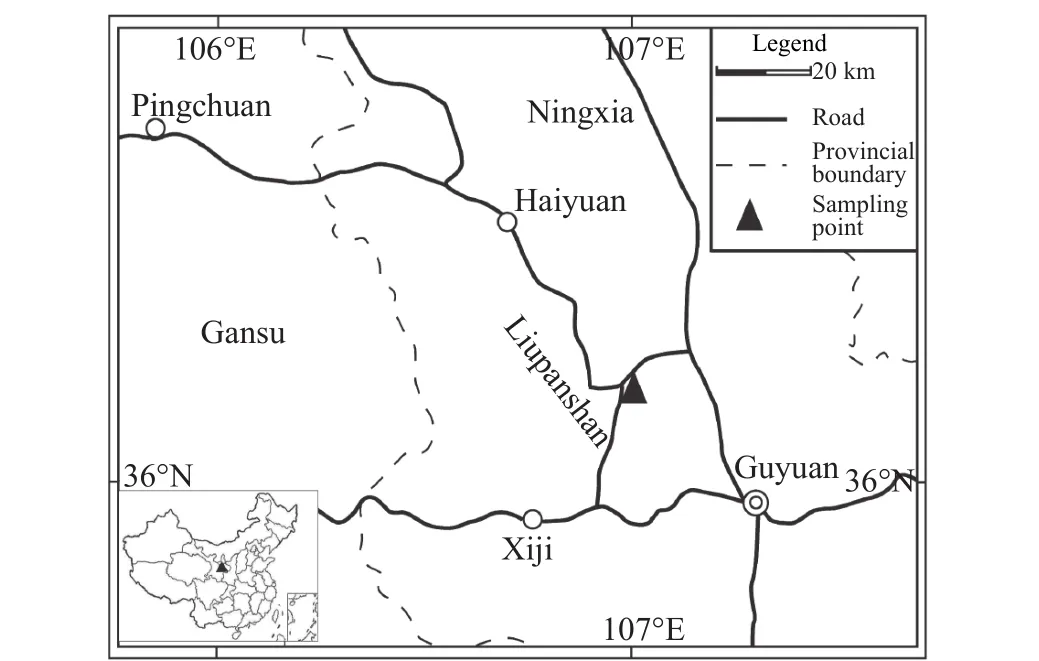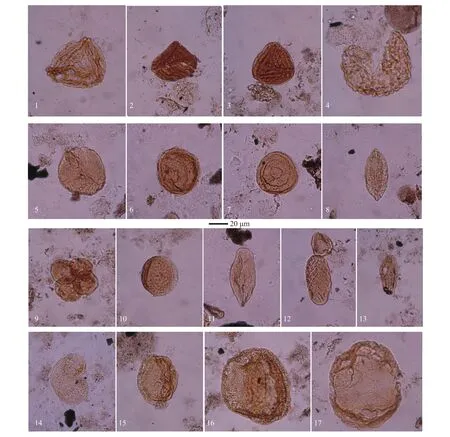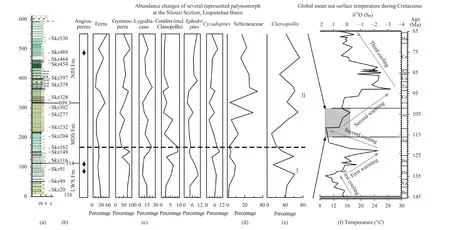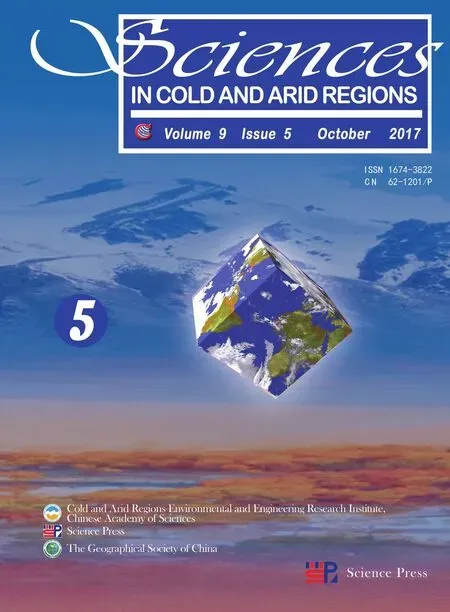Palynological assemblage in the late Early Cretaceous from Sikouzi Section, Liupanshan Group, Central China and its implication to paleoenvironment change
Qiang Zhu , Shuang Dai , YongBo Huang , JunWei Liu
1. Northwest Institute of Eco-Environment and Resources, Chinese Academy of Sciences, Lanzhou, Gansu 730000, China
2. Key Laboratory of Western China's Environmental Systems (Ministry of Education), College of Earth and Environmental Sciences, Lanzhou University, Lanzhou, Gansu 730000, China
3. Shandong Institute of Geological Survey, Jinan, Shandong 250013, China
4. No. 4 Institute of Geological &Mineral Resources Survey of Henan, Shangqiu, Henan 476100, China
Palynological assemblage in the late Early Cretaceous from Sikouzi Section, Liupanshan Group, Central China and its implication to paleoenvironment change
Qiang Zhu1*, Shuang Dai2, YongBo Huang3, JunWei Liu4
1. Northwest Institute of Eco-Environment and Resources, Chinese Academy of Sciences, Lanzhou, Gansu 730000, China
2. Key Laboratory of Western China's Environmental Systems (Ministry of Education), College of Earth and Environmental Sciences, Lanzhou University, Lanzhou, Gansu 730000, China
3. Shandong Institute of Geological Survey, Jinan, Shandong 250013, China
4. No. 4 Institute of Geological &Mineral Resources Survey of Henan, Shangqiu, Henan 476100, China
The Cretaceous (ca. 145 Ma~65 Ma) was characterized by remarkable greenhouse conditions which was more server than present greenhouse gas emissions. However, this special climate condition is mainly documented from marine records. The information derived from continental sediments including terrestrial vegetation is relatively scarce. Here, we report on a palynological study of 17 samples from the Lower Cretaceous Liupanshan Group of the Sikouzi Section (spanning 116 Ma~103 Ma), Liupanshan Basin and analyzed for paleoclimate implications. The palynoflora is diverse, dominated by Classopollis (Cheirolepidiaceae), with abundant ferns and rare angiosperms. The dominant ferns are from Lygodiaceae and Schizaeaceae. The palynological data shows that the Early Cretaceous floras are derived from various settings, i.e., the Coniferales on high elevation mountains, Cheirolepidiaceae along low hills near lakes, ferns in marsh wetlands, and algae in fresh water lakes. The palynoflora indicates that the climate in the Liupanshan area is hot and dry, and the palaeogeography is characterized by complex and various outlook during the Early Cretaceous, furthermore, climate evolution revealed by the vegetation can be divided into two stages during this period. From 116 Ma to 112 Ma, the concentration of thermophilic and xerophilous species such as Cheirolepidiaceae and Schizaeaceae were relatively low, conifers increased significantly, and fern concentration remained steady. This ecosystem suggests a humid and cold climate during this period. From 112 Ma to 103 Ma, the concentration of Cheirolepidiaceae and Schizaeaceae was relatively high, and conifers decreased significantly. Compared to the upper stage, the total percentage of Lygodiaceae spores were relatively low. Vegetation change during this period may indicate an increased trend of a dry and hot environment in this region. The trend of climate change recorded by the pollen assemblages during this period coincide with global sea surface temperature fluctuation. Thus, climate change recorded by the palynological assemblage in the Sikouzi section correlates well with global climate change during the Early Cretaceous.
Early Cretaceous; palynology; palaeoclimate; Liupanshan Basin
1 Introduction
The Cretaceous (ca. 145 Ma–65 Ma) was one of the most remarkable periods in geological history,with a greenhouse climate and global ocean-continental transformation, reconstruction of atmosphere circulation and biology evolution, which played a crucial role on the formation of present global tectonicenvironmental patterns (Royer, 2006; Fletcher et al.,2008; Wang et al., 2014). It is considered to be the latest typical "Greenhouse Earth" state (Crowley and Kim, 1995; Herman and Spicer, 1996) because of high global sea level (Haq et al., 1987; Stoll and Schrag, 1996; Miller et al., 2005), high CO2concentration (Berner, 1994; Crowley and Kim, 1995; Herman and Spicer, 1996; Berner and Kothavala, 2001)and increasing mean temperature (Crowley and Kim,1995; Herman and Spicer, 1996; Gradstein et al.,2004; Keller, 2008). Thus, in order to understand the formation of present environmental patterns and its future evolution process, it has great significance to research on Cretaceous eco-environmental change.
The Liupanshan Basin, located in the hinterland of northern China, is the transition belt between eastern Chinese monsoonal and northwestern Chinese arid regions. It is a Mesozoic and Cenozoic depressed basin which developed on a Proterozoic crystalline basement. The basin contains about 2,000 m of continental Mesozoic to Cenozoic sediments, including the Upper Triassic, Upper Jurassic, Lower Cretaceous and Oligocene to Pleistocene sediments (GBGMR, 1989;Jiang et al., 2007; Wang et al., 2011; Zhang et al.,2012) and paleosol-loess sequence (Yang et al.,2001). During the Cretaceous, thick continental sediments were deposited in the Liupanshan Basin(Liupanshan Group), with abundant plant and animal fossils, important in understanding the eco-environment evolution process in this region. Numerous studies have been made on Ostracod and pollen assemblages, biostratigraphy, and paleo-eco-environment change. Qi (1987, 1988) and Li (1995) considered the Liupanshan Group as belonging to the Hauterivian-Albian in Early Cretaceous based on Ostracod assemblages in Shixianzi Section north of Guyuan, Ningxia Hui Autonomous Region, and Anguo Section in Pingliang, Gansu Province, respectively.Liu (1983) analyzed pollen assemblages in the Liupanshan Group and believed it was deposited in the Berriasian-Aptian. Li and Du (2006) considered the group belonged to the early, middle Albian or late Aptian to early, middle Albian, and the climate was relatively hot and arid based on pollen assemblages from the Anguo Section in Pingliang. Obviously, the biostratigraphic age of this basin is still under dispute due to discrepant explanations on pollen assemblages and Ostracod assemblage from different sections. This discrepancy hampers accurate understanding of the palynoflora and its relationship with the paleoenvironment and global climate change in the early Cretaceous of the Liupanshan Basin. This paper provides new insights on pollen assemblages from Sikousi Section, Liupanshan Group, Central China, whose age is controlled by high-resolution magnetostratigraphy,and establishes the palynoflora in the late Early Cretaceous. We also discuss paleoecology and paleoclimate in the Liupanshan Basin, and its response to global climate change.
2 Geological setting
The lower Cretaceous Liupanshan Group in Liupanshan Basin, divided into five formations, Sanqiao, Heshangpu, Liwaxia, Madongshan, and Naijiahe from bottom to top, is well developed and extensively outcropped, with a thickness of 1,300~3,000 m.The sediments in Liupanshan Basin are composed of purple conglomerates, gravelly sandstones interbedded sandstones (Sanqiao Formation to Heshangpu Formation), brown mudstones, limestones, sandstones interlayered with thin bedded to thick bedded grey limestones, light greygreen sandstones and with little gypsum mudstones (Liwanxia Formation to Naijiahe Formation).
The Sikouzi Section is located in Sikouzi, Guyuan, south of Ningxia Hui Autonomous Region,China (Figure 1). The stratigraphy includes upper Liwaxia Formation to Naijihe Formation with a thickness of 584.9 m, which belongs to a shallow–semideep lacustrine deposit (Figure 2; Dai et al., 2009).This section excludes early sediments due to faults.The lithology profile is as follows:
Naijiahe Formation: grey-light grey green calcareous mudstone, shale interlayered with thin bedded limestones, thin sandstones and gypsum, thickness of 276.9 m.

Figure 1 Location of sampling site-Sikouzi Section from Guyuan, Ningxia
Madongshan Formation: light grey green, grey yellow mudstones interbedded with limestones, and little grey black mudstones and shales, thickness of 194 m.
Liwaxia Formation: light grey green mudstones interlayered grey yellow muddy limestones, thickness of 114 m.
3 Material and methods
In this study, the sampling site is located about 35 km northwest of Guyuan, from the upper Liwaxia Formation to the Naijiahe Formation with a total stratigraphy thickness of 587.9 m. During sampling,the upper surface of alteration was removed to a maximum depth of 1~2 m in order to avoid contamination by alteration and weathering. Each sample is about 500 g, with a total of 17 samples collected, including 3 samples from the Liwaxia Formation, and 14 from the Madongshan and Naijiahe formations, respectively (Figure 2).
Samples of about 30~50 g were crushed to the size of 1~3 mm, and bathed in distilled water. Before the chemical procedure, cleaned samples were dried and weighed. The samples were then treated with 10%HCl and 70% HF to remove carbonates and silica.Separation of the palynomorphs from the residue was carried out using a 10-μm nylon sieve. Finally, the palynomorph-bearing residue was mounted on microscope slides using glycerin jelly. All samples were examined with an Olympus CX–31 microscope at Lanzhou University (Gansu Province, China). Photomicrographs were taken with a Canon G72 digital camera. Palynomorph determination followed the methods described by Song et al. (1999, 2000). More than 300 pollen grains were determined in each sample in order to obtain statistically significant palynomorph contents and diversity. All palynomorph slides are deposited at the Key Laboratory of Western China's Environmental Systems, Lanzhou University, China.

Figure 2 Measured stratigraphic succession of the Sikouzi Section in Sikouzi and pollen sampling sites
4 Results
A total of 45 genera and 55 species were discovered in this section. Gymnosperm pollen dominated the palynoflora with about 75.8%, fern spores are abundant with about 26%, and angiosperm pollen are very sparse (Figure 3). The palynological assemblages of all samples show relatively minor changes over the whole section. Conifer pollen dominate the gymnosperms, which include Classopollis(14.5%~75.2%), Podocarpidites (0.0%~1.8%),Araucariacites (0.0%~6.5%), and Callialasporites(0.0%~4.6%). The Cycadales, such as Cycadopites account for 0.0%~8.7%, while the Ephedrales, such as Ephedripites account for 0.0%~12.5%. The underdeveloped bisaccates of unknown botanical affinity account for 1.4%~22.3% which include Erlianpollis,Protopicea, Protopinus, and Protoconiferus. Other unclassified types that are common include Cerebropollenites (0.0%~21.4%) and Jiaohepollis(0.9%~10.9%). The contents of fern spores were abundant. The most abundant type is Schizacoisporites (0.0%~38.5%); The Lygodiaceae and Cyatheaceae are relatively low, with Ciatricosisporites (0.0%~21.2%), Contignisporites (0.0%~1.6%),Appenaicisporites (0.0%~4.8%) and Cyathidites(0.0%~6.6%). Spores of Osmundaceae and Cyatheaceae respectively accounts for 0.0%~7.5%and 0.0%~4.8%. Unclassified spore types include Yichangsporites (0.0%~5.8%), Wulongspora(0.0%~3.2%), Neoraistrickia, and Leptolepidites. Angiosperm pollen are very rare and usually damaged,creating difficulty for species identification. Thus, we classify these species as tricolpate angiosperm pollen.Lastly, some algae were also shown.
The further analysis of the palynomorph distributions and contents on the section during 116 to 103 Ma show an obvious change tendency in content. Palynomorph distributions on the section have minor change. Thus, two palynomorph assemblages can be established (Figure 4). Palynomorph assemblage I is characterized by relatively low content of Schizaeoisporites, Ephedripites and Classopollis. The fern spore content in this assemblage has minor fluctuation with relatively high level. In contrast, Schizaeoisporites, Ephedripites and Classopollis show slightly increase tendency in palynomorph assemblage II. The bisaccate pollen decreases in contents, while fern spore content shows an obvious fluctuation.

Figure 3 Early Cretaceous spores and pollen from Liupanshan mountain area, Ningxia. 1, Cicatricosisporites subrotundus; 2, 3,Cicatricosisporites hallei; 4, Leptolepidites sp.; 5, Punctatisporites sp; 6, 7, Yichangsporites tricyclosus; 8, Cycadopites sp.; 9,Classopollis annulatus; 10, Perinopollenites elatoides; 11, Jugella claribaculata; 12, Schizacoisporites sp.; 13, Ephedripites(Ephedripites) sp.; 14, Cedripites arcuatus; 15, Jiaohepollis verus; 16, Paleoconiferus asaccatus; 17, Protopinus sp
5 Discussion
5.1 Palynostratigraphical analysis of Sikouzi Section
The aforementioned palynological results are very similar to the Fuxin Formation in Tieling (Wu and Lei, 2007), Yimin Formation in the Hailaer Basin (Li et al., 2007), and Gecun Formation in the Subei Basin(Zhang and Li, 2000). The tricolpate angiosperm pollen which firstly emerged in the Aptian are very scarce in these formations. Ciatricosisporites and Schizacoisporites are abundant and diverse. The representative forms of late Early Cretaceous, such as Yichangsporites, Wulongspora and Hsuisporites rugatus were all emerged in this area. Also, the occurrence of main spore and pollen types are similar at these sites. These palynostratigraphical analysis indicate an Aptian to Albian age for the Sikouzi Section,which is consistent with a magnetstratigraphic chronology of 116.2 Ma to 103.7 Ma (Dai et al., 2009;Liu, 2010).
5.2 Paleoclimatic changes in the Liupanshan area
Numerous studies have shown the paleoecological significance of studying in situ fossil spore and pollen assemblages (Couper, 1957; Norris, 1967; Traverse, 1988; Balme, 1995; Wang et al., 1995; Wang,1999). Based on palynomorph assemblages in this study, Gymnosperms and ferns flourished, followed by Cycadales, Ginkgoales and Ephedraceae, in the Liupanshan area during the Late Cretaceous. The fern plants were relatively rare. Most studies have noted that sediments of the Liupanshan Group indicate a shallow-lake and semi-deep lake environment (Kong,2010; Dai et al., 2016). The Cheirolepidiaceae, Schizaeceae, and Lygodiaceae dominate the vegetation around the lake, and conifers grew on distant mountains. Hygrocolous Lygodiaceae, Osmundaceae and other ferns may have also grown near the lakeshore.Lots of aquatic algae grown in the lake. Therefore, putting together the aforementioned assemblages, one can recreate an ecological community for the study site.
There are about five accepted palynofloral provinces proposed by previous studies (Li, 1983; Li and Liu, 1994). They include the northern Disacciatrileti-Cicatricosisporites Province, south-eastern Classopollis-Schizaeoisporites Province, an extensive Transitional Zone, Xizang-Tarim Dicheiropollis Province, and the southern Xizang Araucariacites-Callialasporites Province. Although the Liupanshan Basin was located in the Transitional Zone, the palynoflora of this area is very similar with the south-eastern Classopollis-Schizaeoisporites Province, which indicates an arid-semiarid subtropical climate. Compared with other neighboring palynofloras in the same latitude, Cheirolepidiaceae of Liupanshan are most abundant. This may indicate an inland dry and hot climatic zone.
Figure 4 shows the relative abundance of palynomorph groups in the studied section. The sporopollen spectrum shows that the palynoflora was dominated by Classopollis (Cheirolepidiaceae), Schizaeoisporites and Ephedripites during 116 Ma~110 Ma. The parent plants of these types were all xerophytic vegetation. In contract, hygrophilous fern spores were low.Thus, a relatively warming climate is indicated by the Sikouzi palynoflora which mostly correspond to global warming trends (Figure 4f). A similar trend is also noted for the Songliao Basin at the eastern edge of Eurasia (Gao et al., 1999). This suggests that continental environmental change is relatively similar to marine environmental change.

Figure 4 The top stratum of Liupanshan Group, relative abundance of palynomorph groups, and graph of the Cretaceous temperature trends. (a) lithology column of the sampled section, m=mudstone, s=sandstone, c=conglomerate;(b) paleomagnetic age of Liupanshan Group (Dai et al., 2009); (c~d) pollen content, Classopollis and Schizaeoisporites in the section; (f) trend of Cretaceous temperature (Keller, 2008)
The two palynomorph assemblages in this study indicate two relatively different climatic stages. Classopollis, signifying an arid environment, present a slightly decreasing trend in PA I (116 Ma~110 Ma).Coniferous bisaccate pollen signifying a cold habitat,shows a sharp increase at the upper boundary of PA I.This data suggests a cooling process in PA I, and is consistent with global cooling during the Aptian–Albian transition which interrupted equably warm climate conditions of the mid-Cretaceous (Mutterlose et al., 2009; McAnena et al., 2013). After this transition,the earth's climate experienced extreme greenhouse conditions of equable trends. Evidence of this condition can be found in the Liupanshan palynoflora(PA II, 110 Ma to 103 Ma) which is characterized by a high percentage of Classopollis, indicating a dry environment. The low percentage of bisaccate pollen reflected a decrease in numbers and diversity of conferspoor conifers vegetation which indicating a relatively warm environment. Thus, climate trends in the late Aptian to Albian sediments of the Liupanshan Basin correspond to global climatic trends.
6 Conclusions
In this study, spores and pollen of 45 genera and 55 species were identified from the Sikouzi Section,Liupanshan Group, of Central China. These pollen assemblages indicate that gymnosperms were dominated in Liupanshan during the Early Cretaceous. The overall flora of this area during the Early Cretaceous suggests a hot and arid environment, with the pollen assemblages divided into two stages (low-temperature stage at 116 Ma to 112 Ma and increasing temperature stage at 112 Ma to 103 Ma). The low temperature stage almost corresponds to global cooling events during the Aptian-Albian transition. The warming stage was relatively stable and is similar to typical mid-Cretaceous hothouse conditions. Thus, climatic changes reflected in the Liupanshan palynoflora during late Early Cretaceous were probably controlled by global climate change.
Balme BE, 1995. Fossil in situ spores and pollen grains: an annotated catalogue. Review of Palaeobotany and Palynology, 87(2–4):81–323. DOI: 10.1016/0034-6667(95)93235-X.
Berner RA, 1994. Geocarb II: A revised model of atmospheric CO2over Phanerozoic time. American Journal of Science, 294(1):56–91. DOI: 10.2475/ajs.294.1.56.
Berner RA, Kothavala Z, 2001. Geocarb III: A revised model of atmospheric CO2over Phanerozoic time. American Journal of Science,301(2): 182–204. DOI: 10.2475/ajs.301.2.182.
Couper RA, 1957. British Mesozoic microspores and pollen grains. A systematic and stratigraphic study. Palaeontographica Abteilung B,103(4–6): 75–179.
Crowley TJ, Kim KY, 1995. Comparison of longterm greenhouse projections with the geologic record. Geophysical Research Letters,22(8): 933–936. DOI: 10.1029/95GL00799.
Dai S, Zhu Q, Hu HF, et al., 2009. Magnetostratigraphy of the Liupanshan group, central China. Journal of Stratigraphy, 33(2): 188–192.DOI: 10.3969/j.issn.0253-4959.2009.02.010.
Dai S, Zhu Q, Huang YB, et al., 2016. Early Cretaceous climate changes recorded in magnetic susceptibility and color index variations of the Lower Liupanshan Group, Central China. Acta Geologica Sinica (English Edition), 90(3): 1011–1023. DOI:10.1111/1755-6724.12741.
Fletcher BJ, Brentnall SJ, Anderson CW, et al., 2008. Atmospheric carbon dioxide linked with Mesozoic and early Cenozoic climate change. Nature Geoscience, 1(1): 43–48. DOI: 10.1038/ngeo.2007.29.
Gansu Bureau of Geology and Mineral Resource (GBGMR), 1989. Regional of Geology of Gansu Province. Beijing: Geological Publishing House, 692.
Gao RQ, Zhao CB, Qiao XY, et al., 1999. Cretaceous Oil Strata Palynology from Songliao Basin. Beijing: Geological Publishing House,pp. 80–81.
Gradstein FM, Ogg JG, Smith AG, et al., 2004. A Geologic Time Scale 2004. Cambridge: The Cambridge University Press, pp.355–358.
Haq BU, Hardenbol J, Vail PR, 1987. Chronology of fluctuating sea levels since the Triassic. Science, 235(4793): 1156–1167. DOI:10.1126/science.235.4793.1156.
Herman AB, Spicer RA, 1996. Palaeobotanical evidence for a warm Cretaceous Arctic Ocean. Nature, 380(6572): 330–333. DOI:10.1038/380330a0.
Jiang HC, Ding ZL, Xiong SF, 2007. Magnetostratigraphy of the Neogene Sikouzi section at Guyuan, Ningxia, China. Palaeogeography,Palaeoclimatology, Palaeoecology, 243(1–2): 223–234. DOI:10.1016/j.palaeo.2006.07.016.
Keller G, 2008. Cretaceous climate, volcanism, impacts, and biotic effects. Cretaceous Research, 29(5–6): 754–771. DOI: 10.1016/j.cretres.2008.05.030.
Kong L, 2010. Measurement and paleoclimatic significance of color and clay minerals of sediments of Liupanshan group. Lanzhou:Lanzhou University.
Li CB, Wan CB, Qiao XY, et al., 2007. Pollen and spore assemblages of the Yimin Formation of Haican-1 well, Hailaer Basin and their stratigraphic significance. Journal of Stratigraphy, 31(1): 23–34.DOI: 10.3969/j.issn.0253-4959.2007.01.003.
Li JG, Du BA, 2006. Palynofloras from the Liupanshan Group (Cretaceous) at Anguo Town of Pingliang, Gansu. Acta Palaeontologica Sinica, 45(4): 498–513. DOI: 10.3969/j.issn.0001-6616.2006.04.006.
Li WB, 1983. Microfloral Area of Early Cretaceous in China. Beijing:Science Press, pp. 142–151.
Li WB, Liu ZS, 1994. The Cretaceous palynofloras and their bearing on stratigraphic correlation in China. Cretaceous Research, 15(3):333–365. DOI: 10.1006/cres.1994.1021.
Li ZW, 1995. Ostracoda in Liupanshan Group from the Anguozhen of Pingliang City, Gansu. Acta Geologica Gansu, 4(2): 10–21.
Liu JW, 2010. The Early Cretaceous deposit and tectonic evolution of Liupanshan Basin. Lanzhou: Lanzhou University.
Liu ZS, 1983. Early Cretaceous sporo-pollen assemblages from Liupanshan of Ningxia and their bearing on paleo-vegetation and paleo-climatology. Acta Palaeontologica Sinica, 22(5): 517–526.
McAnena A, Fl?gel S, Hofmann P, et al., 2013. Atlantic cooling asso-ciated with a marine biotic crisis during the mid-cretaceous period.Nature Geoscience, 6(7): 558–561. DOI: 10.1038/ngeo1850.
Miller KG, Kominz MA, Browning JV, et al., 2005. The Phanerozoic record of global sea-level change. Science, 310(5752): 1293–1298.DOI: 10.1126/science.1116412.
Mutterlose J, Bornemann A, Herrle J, 2009. The Aptian-Albian cold snap: Evidence for "mid" Cretaceous icehouse interludes. Neues Jahrbuch für Geologie und Pal?ontologie-Abhandlungen, 252(2):217–225. DOI: 10.1127/0077-7749/2009/0252-0217.
Norris G, 1967. Spores and pollen from the Lower Colorado Group(Albian-?Cenomanian) of central Alberta Palaeontographica Abteilung B, 120(1–4): 72–115.
Qi H, 1987. Ostracods from the lower part of Liupanshan Group in Guyuan area, Ningxia. Professional Papers of Stratigraphy and Palaeontology, (2): 117–146.
Qi H, 1988. Ostracods from the upper part of Liupanshan Group in Guyuan area, Ningxia. Professional Papers of Stratigraphy and Palaeontology, (4): 85–137.
Royer DL, 2006. CO2-forced climate thresholds during the Phanerozoic. Geochimica et Cosmochimica Acta, 70(23): 5665–5675. DOI:10.1016/j.gca.2005.11.031.
Song ZC, Zheng YH, Li MY, et al., 1999. Fossil Spores and Pollen of China (I): Late Cretaceous Tertiary Spores and Pollen. Beijing:Science Press, pp. 741–745.
Song ZC, Shang YK, Liu ZS, et al., 2000. Fossil Spores and Pollen of China (II): The Mesozoic Spores and Pollen. Beijing: Science Press.
Stoll HM, Schrag DP, 1996. Evidence for glacial control of rapid sea level changes in the Early Cretaceous. Science, 272(5269):1771–1774. DOI: 10.1126/science.272.5269.1771.
Traverse A, 1988. Paleopalynology. Boston: Unwin Hyman, pp.1–600.
Wang FX, Qian NF, Zhang YL, et al., 1995. Pollen Flora of China.2nd ed. Beijing: Science Press, pp.1–461.
Wang WT, Zhang PZ, Kirby E, et al., 2011. A revised chronology for Tertiary sedimentation in the Sikouzi Basin: Implications for the tectonic evolution of the northeastern corner of the Tibetan Plateau.Tectonophysics, 505(1–4): 100–114. DOI: 10.1016/j.tecto.2011.04.006.
Wang YD, 1999. Fertile organs and in situ spores of Marattia asiatica(Kawasaki) Harris (Marattiales) from the Lower Jurassic Hsiangchi Formation in Hubei, China. Review of Palaeobotany and Palynology, 107(3–4): 125–144. DOI: 10.1016/S0034-6667(99)00025-1.
Wang YD, Huang CM, Sun BN, et al., 2014. Paleo-CO2variation trends and the Cretaceous greenhouse climate. Earth-Science Reviews, 129: 136–147. DOI: 10.1016/j.earscirev.2013.11.001.
Wu BW, Lei AG, 2007. Early Cretaceous spore and pollen assemblages from the Tieling Basin, Liaoning Province. Acta Micropalaeontologica Sinica, 24(1): 89–97. DOI: 10.3969/j.issn.1000-0674.2007.01.008.
Yang D, Fang XM, Song YG, et al., 2001. Development of a pediment on western slopes of Liupan Mountain related to the Neotectonic Uplift. Chinese Science Bulletin, 46(S1): 11–15. DOI:10.1007/BF03187229.
Zhang MZ, Dai S, Zhang YQ, et al., 2012. Early Cretaceous Palynological assemblage and its environmental significance in the sediments of Liupanshan Group (Sikouzi section), Liupanshan Region,central China. Arid Land Geography, 35(1): 99–108. DOI:10.13826/j.cnki.cn65-1103/x.2012.01.002.
Zhang YY, Li JG, 2000. Cretaceous palynofloral succession of the Jiangsu Area. Journal of Stratigraphy, 24(1): 65–71. DOI:10.3969/j.issn.0253-4959.2000.01.010.
: Zhu Q, Dai S, Huang YB, et al., 2017. Palynological assemblage in the late Early Cretaceous from Sikouzi Section, Liupanshan Group, Central China and its implication to paleoenvironment change. Sciences in Cold and Arid Regions, 9(5): 0488–0494.
10.3724/SP.J.1226.2017.00488.
*Correspondence to: Qiang Zhu, Northwest Institute of Eco-Environment and Resources, Chinese Academy of Sciences,Lanzhou, Gansu 730000, China. Tel: +86-931-8267850; E-mail: zhuq06@foxmail.com
January 28, 2017 Accepted: July 17, 2017
 Sciences in Cold and Arid Regions2017年5期
Sciences in Cold and Arid Regions2017年5期
- Sciences in Cold and Arid Regions的其它文章
- High-quality draft genome sequence of Streptomyces agglomeratus 5-1-8 with strong anti-MRSA ability, isolated from the frozen soil of Tibet in China
- Intrastorm stemflow variability of a xerophytic shrub within a water-limited arid desert ecosystem of northern China
- Complex network analysis of climate change in the Tarim River Basin, Northwest China
- Contamination and risk assessment of heavy metals in farmland soils of Baghrash County, Xinjiang,Northwest China
- Chemistry and environmental significance of aerosols collected in the eastern Tianshan
- Characteristics of thawed interlayer and its effect on settlement beneath embankment in permafrost regions-A case study for the Qinghai-Tibet Highway
